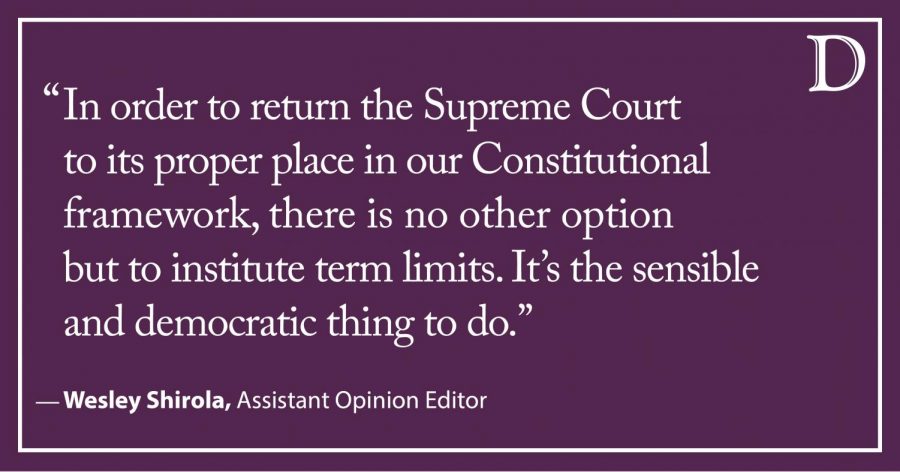Shirola: Supreme Court Justices need term limits
January 20, 2020
The United States is the only major democratic nation where those selected to sit on the bench of its highest court receive lifetime appointments. While lifetime tenure isn’t guaranteed — the U.S. Constitution allows for the resignation, retirement and impeachment of Supreme Court justices — most serve well past their primes; almost half die on the bench.
America’s Founding Fathers granted life tenure to Supreme Court justices to “preserve the total independence of the judiciary,” said Northeastern law professor Michael Meltsner, who specializes in the Supreme Court. This ensures that justices are free to issue rulings based solely on the law, rather than political influences like elections.
Logically, this seems to make sense. But a lot has changed since the Constitution was drafted in the late 1700s. Most strikingly is the drastic change in life expectancy. When the Founding Fathers guaranteed life tenure, the average life expectancy was only about 40 years. Today, however, it is nearly 80 years.
This fact alone is enough for me to advocate for the institution of term limits. Justice Ruth Bader Ginsburg is currently the oldest member on the bench. At 86 years of age, she is around the same age as my grandmother. I love my grandmother dearly, and though she has noticeably declined in her physical capabilities, she is still in possession of most of her cognitive faculties. But by no means is she sharp enough to be making legal rulings that can reshape the course of the country for years to come.
Admittedly, not everyone ages at the same rate, but according to the National Institutes of Health, there is clear evidence that important cognitive skills decline with age, especially after age 70. Historically, most justices have served well past this age and three of the nine justices currently on the bench exceed this mark. Justice Ginsburg, though, has shown the most demonstrable signs of deterioration and there is no shortage of evidence that she should step down. It is simply ignorant not to.
Waves of concern spread through Washington D.C. last November when news broke that Ginsburg had been hospitalized. Thankfully, she returned home a few days later after what had been called “fevers and chills.” Unfortunately, this has not been the only incident. Her hospital trip came only days after she had to leave the bench due to a stomach bug. The list goes on.
Ginsburg, a four-time cancer survivor, was treated for pancreatic cancer last August. In December 2018 she underwent major surgery to remove cancerous nodules from her left lung, causing her to miss two weeks of oral arguments the next January. Earlier that year, Ginsburg took a significant fall in her office, fracturing multiple ribs and having to undergo more medical procedures.
Ironically, Justice Ginsburg has vowed on numerous occasions to stay on the court for as long as her health holds and she stays mentally sharp. In a 2013 interview, she signaled her intention to stay on the bench “as long as I can do the job full-steam.”
Clearly, Ginsburg is not in good health. Watch any recent interview of her, and I think it will be clear that her mental sharpness is weakening as well.
I want to make it well-known that I do not mean to berate Justice Ginsburg. Battling sexism her entire career, she became only the second woman to be appointed to the Supreme Court. Indeed, she is a role model for what every young girl in America is capable of achieving.
Nevertheless, her unwillingness to retire on her own accord is grossly negligent and is a striking example of why it is time to introduce term limits for Supreme Court justices.
Gabe Roth, the executive director of the reform group Fix the Court, told The Atlantic in 2015 that life tenure “is undemocratic by nature.” He went on to say that “it sounds more like an oligarchy or a feudal system.”
As a result, Fix the Court has developed a bipartisan proposal for instituting Supreme Court term limits. Each justice would serve an 18-year term, with vacancies opening up every two years. Not only would this stop justices from serving beyond their primes, but it would also ensure that every president would have at least two appointments in every term, hopefully bringing an end to the fierce partisan battles that have so-often occurred during past Supreme Court appointments and confirmation hearings.
This is just one plan out there. Presumably there are others. Regardless, abandoning life tenure is crucial for the survival of the Court and our country. This shouldn’t be done immediately—any policy implementing term limits would need to be carefully thought out and crafted—but it should be done soon.
The Supreme Court’s role in American politics is ever-expanding. Every year its role in society enlarges as more and more divisive issues fall under the scope of the Court. In order to return the Supreme Court to its proper place in our Constitutional framework, there is no other option but to institute term limits. It’s the sensible and democratic thing to do.
Wesley Shirola is a Weinberg junior. He can be contacted at wesleyshirola2021@u.northwestern.edu. If you would like to respond publicly to this column, send a Letter to the Editor to opinion@dailynorthwestern.com. The views expressed in this piece do not necessarily reflect the views of all staff members of The Daily Northwestern.



